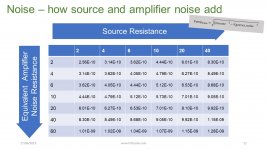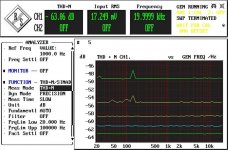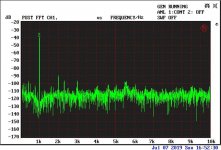I'm recommending Zsource = Zin only for the common base Duraglit which has no other significant noise sources apart from rbb' & the load resistor in practice.
And I'm saying these concepts don't apply here. We are not dealing with EM waves and match terminated systems. For simple transducers the real part of the impedance and it's voltage noise is what matters. If you choose to use the concept of noise figure the optimum is 0dB in this case, in actuality asymptotic.
3mA/device limit for Ye Olde Unobtainium Shoppe devices is from practical testing circa 1980. No improvement in noise beyond that even for the matched conditions.
5mA/device for ZTX is from inspection of Wayne's and H&H data. IIRC, H&H may have said something like 5mA is a sweet spot or that might have been Wayne. No surprise as we were looking at the same data.
Doesn't make much sense. I'd rather believe that beyond 3mA your capability of measuring noise was limited. The noise improvement by increasing the collector current is obvious in that range, since 1/2gm is still far larger than Rbb. If any, high injection level effect should appear at much higher currents.
I quote this in my MicBuilders document and it applies to specific Ortofon cartridges.
The context is that I believe Duraglit & Gerhad represent the SOTA for real-life devices though Gerhad has never tried his in a MC vinyl playing system. In the MicBuilders document, I also point out that Gerhad's amp will have a NF of 2dB for those Ortofon cartridges so that's the maximum noise 'improvement' possible.
While Duraglit does well in a Ein willy-waving comp (as shown by Bonsai) it is really the performance with real-life MC cartridges that is my main interest .. and likely the interest of those here who want to build something useful. (Cue 2 pages of Guru Wurcer on record noise drowning ... 😉)
Please post a link to this much quoted MicBuilders document. I can't find it.
Please define "SOTA for real-life devices".
Please explain why "a NF of 2dB for those Ortofon cartridges" is the "maximum noise 'improvement' possible". It doesn't make sense to me, together with using NF in this context. NF is a useless metric when it comes to audio reproduction since, as others already mentioned, the concept of maximum power transfer by matching impedances doesn't apply.
Please explain why "Duraglit" would perform better with real-life MC cartridges, compared to other approaches. I don't see any technical reasons why.
Actually, comparison is with Leach's original version in Audio magazine where the improvement is greater than 10dB for both noise & THD. Duraglit was the result of a friend building the Audio magazine Leach and his dissappointment. I said I would make him a better one. The story is in my MicBuilder's document.
May I ask again why you chose to build & test his current mirror version even though Leach himself admits it is inferior?
BTW, thanks for your practical experiments with the solar cells. I don't think the picture is complete yet and there are more improvements possible but its an important step forward. Need to get some beach bum stuff out of the way and see if I can still pre10 to use LTspice.
Are you sure? Please provide a link or any other relevant reference to this Audio Magazine, showing a greater than 10dB improvement. Improvement in what parameters?
Your question was already answered:
(...)did I mention I hate matching transistors and adjust each circuit for transistors Beta to avoid (quasi)saturation?
Since the current mirror version has the noise very close to the theoretical value and distortions are as good as one can get from a bipolar open loop design, I find this version much better from a practical perspective.
LTSpice won't help with any of the solar cell aspects.
I've never claimed Zsource = Zin is the Universal answer to World Peace and improved Sex Life .. only with Duraglit.
It comes from Rnv = 1/(2 gm) for both common base & common emitter.
But Rni = 2/gm for common base and
Rni = hfe * 2 / gim for common emitter.
I'm recommending Zsource = Zin only for the common base Duraglit which has no other significant noise sources apart from rbb' & the load resistor in practice.
Lesser common base designs have other noise sources so this 'optimum' isn't so clear cut.
Baxandall's 1967 article explains the 3dB NF etc and I'm sure, his references, H&H and others too .. though perhaps not as clearly.
For THD, I'll just say that for LoZ cartridges, the MCs which demand the best noise performance, reducing Duraglit's input impedance by running more current improves THD with the cartridge
As others already mentioned, the concept of matching impedances for maximum power transfer is nonsense for audio. I don't see any serious technical reason for applying this concept to the "Duraglit", whatever formulas you are quoting and whatever they mean to you. Quoting Baxandall is here out of context as well.
Please explain why "lesser common base designs have other noise sources so this 'optimum' isn't so clear cut". According to the common body of knowledge, intrinsic device noise sources are the same, disregarding the circuit topology.
Please explain why "reducing Duraglit's input impedance by running more current improves THD with the cartridge" and anyway, why is this true only for the "Duraglit". BTW, you just mentioned a few messages up that the concept of optimal MC cartridge loading is not important.
This is certainly important for MM. See eg Wayne's detailed results on proaudiodesignforum.
But it's nonsense for MC and probably low inductance MMs like the Grados.
As you can see, your answers raised more question than they addressed, so if you feel like answering, please be concise and at the point. Unfortunately I'm not a beach bum yet, so my time of going through and filtering the chaff from your postings is limited.
Here is a table of amplifier noise and source resistance noise. It shows the combines amplifier vs source resistance noise.
Select your source resistance on the x axis and your amplifier equivalent noise resistance on the y axis. The intercept is the total input referred noise.
Select your source resistance on the x axis and your amplifier equivalent noise resistance on the y axis. The intercept is the total input referred noise.
Attachments
Last edited:
- Distortions for the circuit shown in https://www.diyaudio.com/forums/ana...tra-low-noise-mc-head-amp-38.html#post5841706 From bottom up, Vin=0.5mVeff to 2.5mVeff in 0.5mVeff steps. 0.007% for a typical MC cartridge input. Can't get better than this with bipolars, open loop, unless some heavy degeneration is used (at the price of noise). Mr. Duraglit will of course note that other than the topology, the circuit is different from the Leach mirror circuit; degenerations are 1ohm and the circuit runs at 5mA rather than 125uA. Hence, the Leach comments about a higher noise in the current mirror circuit does not apply.
- Distortion spectrum @1KHz and 2.5mVeff, fundamental notched. A little of 2nd and 3rd harmonic, everything else is in the noise floor.
Attachments
To my own experience, rather than hunting down the last drop of noise, it is much useful to invest in shielding the head amp from stray magnetic fields. Down from .5nV/rtHz it's the mains 50/60Hz that dominates the audible artifacts with the idle TT. I used a 12mm thick aluminum enclosure and got the 60Hz component (input referred) down to about 50nV, about 20dB down from the unshielded version, which makes it almost tolerable for a MC gain of 67dB plus 28dB in the power amplifier (a few mV at the speaker terminal, can hear it ears on but not in any far field). I'm pondering about a head amp close to the cartridge, much like electrostatic microphones use, but it's an idea in very early stages.
You can of course rapidly end up at the point where the cartridge itself is picking up more noise than the preamp. Shielding that becomes more challenging. As I discovered helping a friend out recently, ethernet over the mains boxes are evil and put out all sorts of grot that the cartridge will happily pick up.
0.007% for a typical MC cartridge input. Can't get better than this with bipolars, open loop, unless some heavy degeneration is used (at the price of noise)
100 times less that the best case distortion from the vinyl. Personally would mark that as transparent.
I find the noise price perfectly acceptable with degeneration if you are prepared to use enough current (and I never use less than about 60 volts with phono stages).
The MoD and his family covered it up cos Dick Duraglit was a homosexual. 🙂 Now that the 50 yr. Official Secrets Act time frame is over for that period, we might see the truth emerging. 😀I don’t see his name in the list of the deceased in that crash.
Lydbrook - Halifax crash in WWII on 7 June 1942
Was he under another name?
Last edited:
Select your source resistance on the x axis and your amplifier equivalent noise resistance on the y axis. The intercept is the total input referred noise.
You need to account for current noise effects for some extreme designs.
I'm recommending Zsource = Zin only for the common base Duraglit which has no other significant noise sources apart from rbb' & the load resistor in practice.
All true Guru Wurcer. And I'm suitably reprimanded for using Zsource when I should have been using Re(Zsource) bla bla though for MC cartridges & Duraglit, both Zsource and Zin are essentially resistiveAnd I'm saying these concepts don't apply here. We are not dealing with EM waves and match terminated systems. For simple transducers the real part of the impedance and it's voltage noise is what matters.
For noise, the formal matching condition is of course
Rsource = Roptimum = rt(Rnv * Rni) please excuse my not using Re(bla bla)
It just so happens, for common base, Roptimum = 1/gm
Yes. Gerhad's amp is just over 2dB from this optimum with an Ortofon cartridge and mine nearly a dB worse.If you choose to use the concept of noise figure the optimum is 0dB in this case, in actuality asymptotic.
Last edited:
It just so happens, for common base, Roptimum = 1/gm
I still don't know what you are talking about, take a Denon DL103R 14 Ohms IIRC, the net RTI noise is still going down at 1/gm = 5 Ohms. Optimum means a cusp, worse below and above a certain bias point.
Last edited:
What circuit are you using? Are you measuring total noise?I still don't know what you are talking about, take a Denon DL103R 14 Ohms IIRC, the net RTI noise is still going down at 1/gm = 5 Ohms. Optimum means a cusp, worse below and above a certain bias point.
All true Guru Wurcer. And I'm suitably reprimanded for using Zsource when I should have been using Re(Zsource) bla bla though for MC cartridges & Duraglit, both Zsource and Zin are essentially resistive
For noise, the formal matching condition is of course
Rsource = Roptimum = rt(Rnv * Rni) please excuse my not using Re(bla bla)
It just so happens, for common base, Roptimum = 1/gm
Yes. Gerhad's amp is just over 2dB from this optimum with an Ortofon cartridge and mine nearly a dB worse.
Richard, you still don't get it. There is no noise source/load optimum for audio. That's because the notion of maximum power transfer doesn't make any sense.
What circuit are you using? Are you measuring total noise?
Your circuit, yes. Though "noise figure" in this context means the output voltage as if it was driving a matched load since noise figure is a power based figure of merit and not applicable in this case.
For this situation I got about .38dB at 12mA of collector current for 2 Ohm RB, beta of 250, and 14 Ohm source as the optimum.
The bandwidth, noise, and gain of that circuit are all functions of beta and RB to some extent. There is also peaking at low frequencies with the values everyone is using, the self biased transistor is still a feedback system.
Please post the *.ASC file you used.Your circuit, yes. Though "noise figure" in this context means the output voltage as if it was driving a matched load since noise figure is a power based figure of merit and not applicable in this case.
For this situation I got about .38dB at 12mA of collector current for 2 Ohm RB, beta of 250, and 14 Ohm source as the optimum.
Guru Wurcer, what would you use for common base Rni ?
I'm using NF in the same sense as designing a mike preamp. ie what is the increase in noise compared to a noiseless preamp for a specified Rsource. eg Noise figure - Wikipedia which makes no mention of matched load.
As a newbie, wannabe LTspice guru, I haven't got to grips with its noise sims. I need to resurrect another computer to run LTspice which I haven't really touched in the last 2 yrs. Need to get some beach bum issues out of the way.
Thanks to those of you who have identified the subsonic problems. I must update the MicBuilders document with that and some of the other stuff that has come up including syn08's Solar Cell experiments. In the meantime, I would choose the critical base electrolytics first (by ESR and listening), then twiddle the other values to tame any subsonic peak.
My somewhat lame excuse for not seeing this in 1980 is that I probably had the B&K voltmeter's 20Hz brickwall filter engaged. Mea maxima culpa
Last edited:
Noise figure - Wikipedia which makes no mention of matched load.
The noise figure is the difference in decibels (dB) between the noise output of the actual receiver to the noise output of an “ideal” receiver with the same overall gain and bandwidth when the receivers are connected to matched sources at the standard noise temperature T0 (usually 290 K). The noise power from a simple load is equal to kTB, where k is Boltzmann's constant, T is the absolute temperature of the load (for example a resistor), and B is the measurement bandwidth.
I'll show some numbers tomorrow.
My apologies Guru Wurcer. Serves me right for pre10ing to reed en rite. 😱The noise figure is the difference in decibels (dB) between the noise output of the actual receiver to the noise output of an “ideal” receiver with the same overall gain and bandwidth when the receivers are connected to matched sources at the standard noise temperature T0 (usually 290 K). The noise power from a simple load is equal to kTB, where k is Boltzmann's constant, T is the absolute temperature of the load (for example a resistor), and B is the measurement bandwidth.
May I ask that we relax the matched load requirement and simply use NF as the increase in noise over rt(4kTBR) multiplied by the effective gain of the amplifier? This is simple and easy to understand for audio .. hence used in specifying eg mixers & mike preamps. If there is a formal name for this metric, please let us know.
________________________
Guru Wurcer, what would you use for common base Rni ?
Last edited:
May I ask that we relax the matched load requirement and simply use NF as the increase in noise over rt(4kTBR) multiplied by the effective gain of the amplifier? This is simple and easy to understand for audio .. hence used in specifying eg mixers & mike preamps. If there is a formal name for this metric, please let us know
Why inventing a square wheel instead of using the standard input referred noise?
syn08, could you post more details about your Solar Cell PSU? What did you use and where did you buy it? Same for the LEDs.
Pics of how you have cobbled them together to minimise noise from ambient light and construction details would be great.
A new & useful addition to the fount of human knowledge and of particular interest in those who wish to construct a MC head amp with SOTA noise 🙂 .. but lack the skills & facilities possessed by Gerard & your good self 🙁
This would help improve S/N ratio .. which as you rightly point out .. has fallen somewhat of late.
Pics of how you have cobbled them together to minimise noise from ambient light and construction details would be great.
A new & useful addition to the fount of human knowledge and of particular interest in those who wish to construct a MC head amp with SOTA noise 🙂 .. but lack the skills & facilities possessed by Gerard & your good self 🙁
This would help improve S/N ratio .. which as you rightly point out .. has fallen somewhat of late.
Last edited:
- Home
- Source & Line
- Analogue Source
- Richard Lee's Ultra low Noise MC Head Amp


